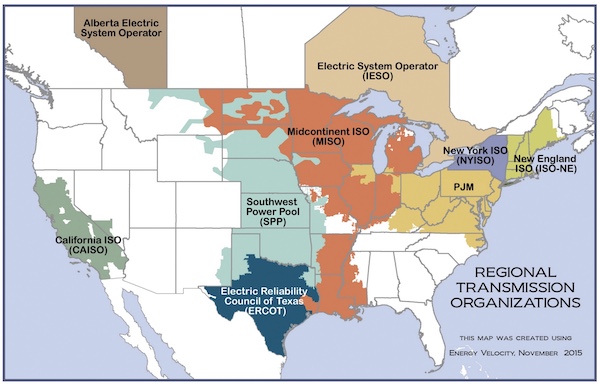
Regional transmission organizations across the US. Source: Federal Energy Regulatory Commission
This post is pretty informal in that I just have point-in-time snapshots of grid mixes from earlier this week. I tried to get mid-day and night snapshots from the main Independent System Operators, shown above, but I couldn’t easily find data for Texas (ERCOT), and my midday snapshots on the west coast end up being afternoon snapshots on the east coast. So this is imperfect, but I hope you will still find it interesting.
We’ll start with California, which is what most of us are most familiar with. Our grid is usually at least half renewables midday, with the vast majority of that being solar. (1) With an additional portion of nuclear and (currently) a very small amount of hydropower, only about one-third of our power on this winter day was coming from fossil fuels. (Imports are largely gas.) That is fantastic and getting better.
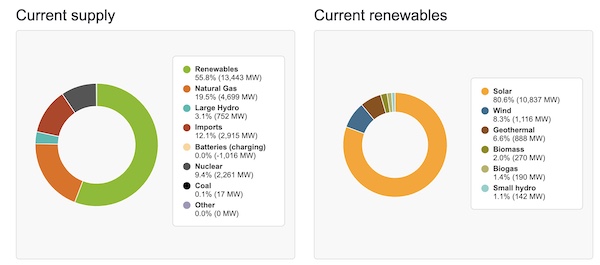
Fuel mix on California’s grid on Wednesday, January 26 at 12:30 pm PST. Source: CAISO
The picture at night is quite different. With the sun having set, you can see that over 70% of our grid is fossil fuel. This is why I encourage people to charge their EVs during the day when possible, and especially to avoid the 4-9pm slot when the grid is dirtiest. One thing that is interesting to me is the emergence of a small slice of battery storage, which is going to get much bigger in the next few years. It’s also interesting to see the potential for geothermal energy, which is reliable and producing nearly half as much energy as wind on this evening.

Fuel mix on California’s grid on Tuesday, January 25 at 8 pm PST. Source: CAISO
New York is an interesting comparison to California. It is also a very environmentally conscious state, and they are working to electrify transportation and buildings much as we are. What does their power supply look like?
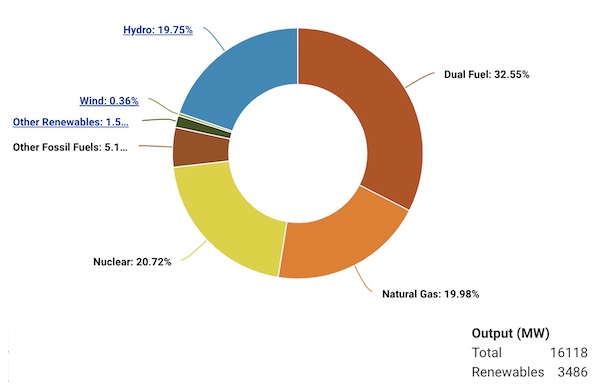
Fuel mix on New York state’s grid on Wednesday, January 26 at 3:30 pm EST. Source: NYISO
What I notice is that there is virtually no solar or wind, and if it weren’t for a very large amount of nuclear energy and hydropower, their grid would be nearly all fossil fuel. Luckily the east coast doesn’t seem to be subject to the droughts that we are having out west.
The other interesting thing is that at night (shown below) the mix is not that different! In fact, in this case the grid at night has slightly lower emissions because demand is lower so less fossil fuel is needed. While flexible demand is essential for California’s solar-heavy grid, it seems to matter much less for New York. I wonder why they have so little wind and solar power, and if/how that is changing.

Fuel mix on New York state’s grid on Tuesday, January 25 at 11 pm EST. Source: NYISO
You can see on the map at the beginning of this post that the New York Independent System Operator (ISO) is bordered to the northeast by the New England ISO and to the southwest by the so-called PJM ISO (2). Do you think these grid mixes look similar to that of New York?
It turns out that both have substantial amounts of gas and nuclear energy, but they differ in other ways. New England, shown below, has very little hydropower and adds a large amount of oil to the fossil gas. Its diverse but small smattering of low-emission sources leave it with a grid that is nearly two-thirds fossil at the time that I looked.

Fuel mix on New England’s grid on Wednesday, January 26 at 3:30 pm EST. Source: ISO-NE

Renewable mix on New England’s grid on Wednesday, January 26 at 3:30 pm EST. Source: ISO-NE
At night the grid is somewhat cleaner because demand is lower so less oil is used. (The renewable mix doesn’t change much from what it is during the day, so I am omitting that chart.)

Fuel mix on New England’s grid on Tuesday, January 25 at 11:30 pm EST. Source: ISO-NE
What about PJM, with Pennsylvania, Virginia, and Ohio. (2) Are you thinking coal? If so, you would be correct. In fact the grid seems to be about one-third coal, one-third gas, and one-third nuclear on this winter afternoon. Nuclear is pretty much the only source of low-emission electricity. You can see also that there is an enormous amount of electricity on this grid, about 5x that of California and 7x that of New York. It is very big and very dirty.
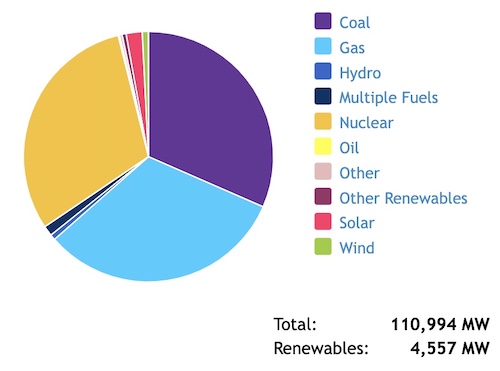
Fuel mix on PJM grid on Wednesday, January 26 at 3:30 pm EST. Source: PJM
At night it doesn’t look much different.
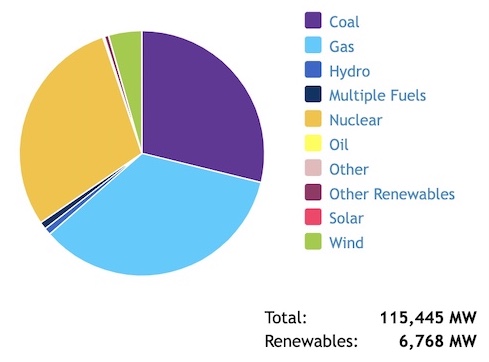
Fuel mix on PJM grid on Tuesday, January 25 at 11:30 pm EST. Source: PJM
You can see from the New York, New England, and PJM operators how crucial nuclear energy is for reducing electricity emissions. New York has pushed out coal by adding more gas and hydropower, as shown in these excellent New York TImes graphics. In New England they largely replaced coal with gas. PJM still has a massive amount of coal left. What have they got up their sleeve besides gas as they move away from coal? Is there an answer other than gas?
There are two remaining operators to look at, both in the midwest. You might think they would look similar to each other, since they are adjacent and span much of the length of the country. And the mixes are very similar.
The Southwestern Power Pool, centered around Kansas, Nebraska, and Oklahoma, has an enormous amount of wind, but only a small amount of nuclear and little else that is fossil-free. With about twice as much coal as gas, their grid is far from clean, though as wind and to some extent gas keep pushing coal out, it is getting cleaner each year. (The night-time mix was almost identical, so I am not including a picture here.)

Fuel mix on Southwest Power Pool’s grid from Wednesday, January 26 at 2:30 pm CST. Source: Southwest Power Pool
The Midcontinent ISO, stretching from Minnesota in the north to Louisiana in the south, looks very similar, but with less wind and more nuclear.
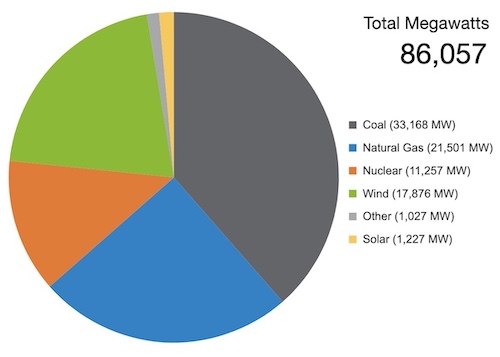
Fuel mix on the Midcontinent ISO’s grid from Wednesday, January 26 at 2:35 pm CST. Source: Midcontinent ISO
I wonder, though, if the wind is more variable in the part of the country spanned by this operator. When I looked in the evening, the wind had dropped by half and gas had picked up the slack.
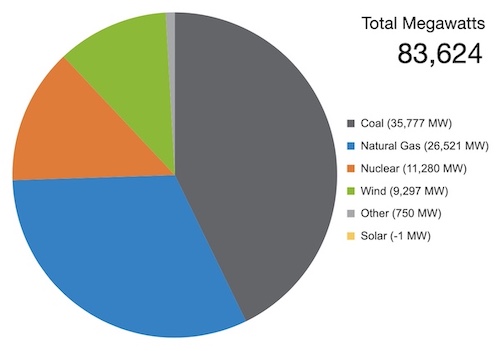
Fuel mix on the Midcontinent ISO’s grid from Tuesday, January 25 at 10:10 pm CST. Source: Midcontinent ISO
This chart from the EPA confirms that the MISO territory has higher emissions than the SPP territory.
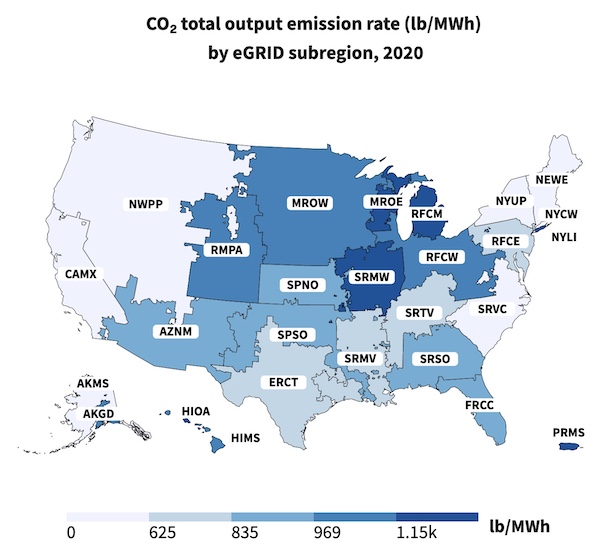
Emissions rates in grids across the country. Source: EPA
What are my takeaways from this exploration? I’m curious what yours are, but mine are:
1. California is doing a terrific job cleaning up its grid, especially during the day, and we should take advantage of that by electrifying and shifting our demand to the daytime hours when possible.
2. The bigger grids (e.g., PJM and MISO) seem to be the dirtiest grids. How hard will it be for them to develop renewables at the scale we need? And how much of a role can efficiency (e.g., building codes) play on these power-hungry grids?
3. There is surprisingly little solar in the rest of the country. I don’t understand why. The sun shines everywhere and solar is pretty inexpensive. Is land the problem? Or managing the variability?
4. There is surprisingly little hydropower in some of the ISO’s in the north. I would like to better understand why, especially given the potential for imports from Canada.
5. Nuclear energy is currently essential for keeping grid emissions down in much of the country.
6. If you click through to the EPA in the chart above, you will see that New York’s grid emissions were less than half that of California’s in 2020 (234 vs 513 lb/MWh). There is something to be said for low-emission energy that works at night! Offshore wind is a good bet for California in that regard.
7. I worry about how we are going to avoid replacing coal with gas since many of the operators seem to have little experience with the more variable renewables. California is fine-tuning its approach with different types of storage while many other states are barely at the starting line on this.
What are your takeaways, questions, or observations?
Notes and References
1. This does not include the “behind the meter” rooftop solar power that is consumed when it is generated.
2. PJM stands for Pennsylvania, New Jersey, and Maryland, though PJM has expanded to cover parts of 13 states since it was founded in 1956.
3. This overview is missing large portions of the country, from the Pacific Northwest, which should be (and is) swimming in hydropower, to the Southeast, which should be (but is not) swimming in solar.
Current Climate Data (December 2021)
Global impacts, US impacts, CO2 metric, Climate dashboard
Comment Guidelines
I hope that your contributions will be an important part of this blog. To keep the discussion productive, please adhere to these guidelines or your comment may be moderated:
- Avoid disrespectful, disparaging, snide, angry, or ad hominem comments.
- Stay fact-based and refer to reputable sources.
- Stay on topic.
- In general, maintain this as a welcoming space for all readers.
Comments that are written in batches by people/bots from far outside of this community are being removed.




